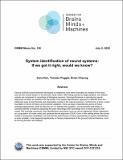| dc.contributor.author | Han, Yena | |
| dc.contributor.author | Poggio, Tomaso | |
| dc.contributor.author | Cheung, Brian | |
| dc.date.accessioned | 2022-07-05T20:07:24Z | |
| dc.date.available | 2022-07-05T20:07:24Z | |
| dc.date.issued | 2022-07-02 | |
| dc.identifier.uri | https://hdl.handle.net/1721.1/143617 | |
| dc.description.abstract | Various artificial neural networks developed by engineers have been evaluated as models of the brain, such as the ventral stream in the primate visual cortex. After being trained on large datasets, the network outputs are compared to recordings of biological neurons. Good performance in reproducing neural responses is taken as validation for the model. This system identification approach is different from the traditional ways to test theories and associated models in the natural sciences. Furthermore, it lacks a clear foundation in terms of theory and empirical validation. Here we begin characterizing some of these emerging approaches: what do they tell us? To address this question, we benchmark their ability to correctly identify a model by replacing the brain recordings with recordings from a known ground truth model. We evaluate commonly used identification techniques such as neural regression (linear regression on a population of model units) and centered kernel alignment (CKA). Even in the setting where the correct model is among the candidates, we find that the performance of these approaches at system identification is quite variable; it also depends significantly on factors independent of the ground truth architecture, such as scoring function and dataset. | en_US |
| dc.description.sponsorship | This work was supported by the Center for Brains, Minds and Machines (CBMM), funded by NSF STC award CCF-1231216. | en_US |
| dc.publisher | Center for Brains, Minds and Machines (CBMM) | en_US |
| dc.relation.ispartofseries | CBMM Memo;136 | |
| dc.title | System identification of neural systems: If we got it right, would we know? | en_US |
| dc.type | Article | en_US |
| dc.type | Technical Report | en_US |
| dc.type | Working Paper | en_US |
